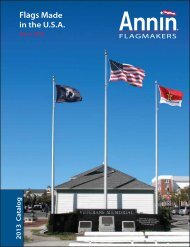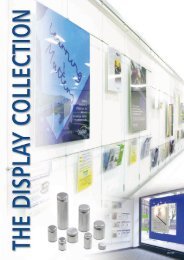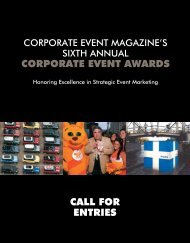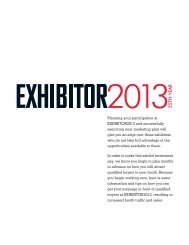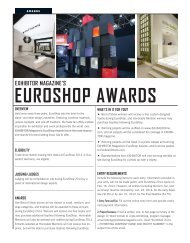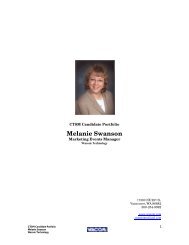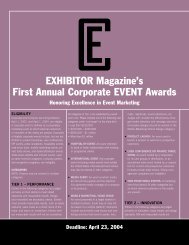Get your FREE PDF article here! - Exhibitor Magazine
Get your FREE PDF article here! - Exhibitor Magazine
Get your FREE PDF article here! - Exhibitor Magazine
- No tags were found...
You also want an ePaper? Increase the reach of your titles
YUMPU automatically turns print PDFs into web optimized ePapers that Google loves.
REPRINT R060322Low Down onLayoutsEverything you need to know about the six most common exhibitfloorplans.-- Linda Armstrong --Note: This is a partial, sample reprint from EXHIBITOR magazine. The full<strong>article</strong> and hundreds more are available at www.<strong>Exhibitor</strong>Reprints.com.Searchable and organized by subject, these <strong>article</strong>s are the best of the bestin trade show and corporate event information.Copyright 2003 by <strong>Exhibitor</strong> magazinewww.<strong>Exhibitor</strong>Online.com
EXHIBITOR REPRINTSBest-Selling Reprints from www.<strong>Exhibitor</strong>Reprints.com:STAFFING -- Reprint R090222The Booth Staffing SolutionHow to turn <strong>your</strong> skeptics, grumps, and slackers into a top team.SALARY SURVEY -- Reprint R07042418th Annual Exhibit Management Salary SurveyEXHIBITOR's 2004 survey points toward recovery, with salaries and trade show budgets on the rise.EEXHIBITS -- Reprint R080015Creating an Exhibit ThemeUse this eight-step formula to brainstorm a killer theme for <strong>your</strong> next promotion.MEASUREMENT -- Reprint R080219How to Measure Live PresentationsUse professional survey techniques to indentify and deliver useful results.REPORTING -- Reprint R040126Life After ROIQuit apologizing for numbers you can't prove. Meet Return On Objectives, the best newmeasurement system you'll actually use.FORM-FUNCTION -- Reprint R090234The Greenhorn <strong>Exhibitor</strong>'s Emergency GuideSuddenly the finger of fate taps you as the company's trade show manager. What now? Here's astep-by-step guide to planning <strong>your</strong> first show.BUDGETING -- Reprint R090140Budgeting Rules of ThumbAn exhibitor's guide to what things cost.EXHIBIT MANAGEMENT -- Reprint R090245Old Booth vs. New BoothA cost-savings grid can help convince management to open the funding gates.
Low DownOn LayoutsEverything you need to know about the six most common exhibit floorplans.By Linda ArmstrongDid you know that a classic diamond style booth layoutis great for a multi-division company, but notoriouslydifficult to staff? Did you know that severaloversized products clutter a random display type of booth,but they’re perfectly at home in a plaza-style layout? Wereyou aware that closed, or club-style exhibits are an awesomecanvas for graphics, but some visitors view them as traps?If you’re like most exhibitors, you probably don’t havea clue. In fact, “t<strong>here</strong>’s a lot of default design and purchasing,”says Tom Bowman, principal of the Bowman DesignGroup of Signal Hill, CA. “If the exhibit house doesn’t showexhibitors the pros and cons of each basic layout, exhibitorsoften think, ‘Hmm... This looks nice, and it seems to fit myneeds. And since I’m not sure what could be wrong or whatmight work better, then, why not? I’ll buy it.’”Sure, some exhibit houses go the extra mile to explain<strong>your</strong> options. But frankly, educating clients isn’t their job.You simply must walk in their doors with a basic understandingof <strong>your</strong> options and a general sense of what willwork best for you.To provide the basics, then, three industry experts haveidentified six core booth layouts and provided some generalguidelines for each. The trio includes Bowman, who providedthe original diagrams, along with Jeremy Regenbogen, principalof San Francisco’s Dual Office (and a 2003 ExhibitDesign Awards judge), and David Albarian, project managerfor Expomobilia, a Swiss firm (with offices in San Diego)specializing in European design. Although our team agreeson the six basic layouts, they caution that variables existwithin each. You can, and should, change each layout’scomponents (theaters, kiosks, monitors, exhibitry), size(both for the booth and components), and positioning(objects rotated at an angle, moved off center, etc.). Butthese core concepts are blueprints for almost all exhibitdesigns, including inlines and peninsulas.Our trio also cautions that t<strong>here</strong>’s no one specific layoutthat’s right for every exhibitor every time. You must mix andmatch layouts and elements to suit each situation. And,what might be a positive for one exhibitor can be a negativefor another. For example, the exclusivity of a closed exhibitcan make those inside feel special and those outside feelrejected. The layout’s impact on <strong>your</strong> program depends onthe location and personality of <strong>your</strong> target audience.Under all the variables, however, are these six core layouts.Our experts have made several generalizations abouteach to provide a sort of “least you should know” guide.Understanding these basics will help you make a confident,informed buying decision the next time around. EBy Linda Armstrong. Questions or comments?E-mail editorial@exhibitormagazine.com.COPYRIGHT EXHIBITOR MAGAZINEEXHIBITOR REPRINT— 3 OF 3 10 —
CLASSIC DIAMONDMain focal point(s) Access Message visibility Traffic flow•Offers strongvisual presence•Requires one largemessage and severalequal smaller ones•Works well fordisplay of multiplesmall products• Simplicity andlack of walls drawpeople in• Lack of boundariesmeans visitors mightleave too soon• Central structureblocks view acrossbooth• Offers only one spotfor a single, highimpactstatement• Generally limitedspace for graphics• Requires carefulstaffing to encouragevisitors to explorewhole booth• Especially largecentral structurecan push visitorsout of boothCENTERPIECE•Works best when oneproduct or messageneeds spotlighting•Requires centralelement worthyof highlighting•Offers little flexibilityover time•Allows easy accessto focal point•Single focuscan’t hold attendees’interest long•Offers great impactfor main message•All graphicsmust supportmain message•Allows easy accessto main focus•Central focuscan attract somuch traffic tocause cloggingTHEATER•Layout drives allattention towardpresentation•Singular focusprevents highlightingof multiple products•Openness encouragesvisitors whodon’t like to ‘commit’to more enclosedpresentations•Offers no captureeffect•Allows strongmedium formessage delivery•Partitions can displaysmaller messages•Back of theaterpushes awaypotential visitors•Undecided visitorscan tie up aisle traffic•Quick exits afterpresentation difficultto preventCLUB•Attendees can’t seemain focus until theystep inside•Interior offers quietoff-floor environment•Exterior walls canattract attention anddeliver messaging•Allows completecontrol over entryand exit of visitors•Limited entrancesdiscourage walk-uptraffic•Exhibit wallsoffer huge canvasfor graphics•Confusion canresult if too manymessages plasteredon walls•Main entranceclogs easily ifbooth is popular•Staff can route trafficthrough key areasbefore allowing exit•Allows use ofmultiple productsand presentationmedia•Prevents highlightof one central focus•Different elementsact as draw fromdifferent sides•Disorder cankeep some visitorsfrom entering•Permits many levelsof messaging•Chaos can workagainst propermessage delivery•Confusing layoutcan be difficultto navigate•Traffic can clogat focal pointRANDOM DISPLAY•Offers open andinviting interior space•Allows all elementsto be seen at once•Doesn’t offer onestriking elementvisible from afar•Openness encouragesvisitors to wanderand explore•Visitors are free toleave as easily asthey enter•Allows placementof large displaygraphics•All product offeringsviewable and accessibleat once•Central elementscan draw too muchtraffic, causingclogging•Staff guides canenable smoothtraffic flowPLAZACOPYRIGHT EXHIBITOR MAGAZINEEXHIBITOR REPRINT— 4 OF 4 10 —
Classic DiamondThe classic diamond is a large, central structure with a series ofindependent elements surrounding it. Often, the central structureis an exhibit tower, perhaps a two-story monolith, maybe includinga storage room, upper-level hospitality area, meeting room, etc.The surrounding elements might include kiosks, demo stations,graphics, product displays, etc. The exhibit doesn’t have to besymmetrical or diamond shaped to fit this model — it just has tohave the same basic positioning.DisadvantageThe central structure blocksthe view from one end of thebooth to another. Attendeesmight not grasp the connectionbetween different companymessages.AdvantageProvides a strong visual presence,which draws people infrom a distance. It’s a canvasfor one powerful message.DisadvantageWith a particularly largecentral structure, internalbooth traffic can bepushed into the aisles,and perhaps lost forever.DisadvantageAttendees tend tostay on the side of theexhibit closest and mostvisible to them. If youwant attendees to seethe whole booth,careful organizationand signage are required.AdvantageBalance is critical. All ot<strong>here</strong>xhibit elements must be of lessimportance to the central structure,but of equal importance to each other.Key Considerations: The central diamondworks well for displaying multiple smallproducts under one company umbrella.But a system to position and track staff isrequired so staff can assist attendees effectively.Also, t<strong>here</strong>’s little long-term flexibility.You’re locked into one central message andequally important surrounding elements.COPYRIGHT EXHIBITOR MAGAZINEEXHIBITOR REPRINT— 5 OF 5 10 —
DisadvantageAttendees tend to comeand go quickly. Oncethey take in the mainmessage, they leave.AdvantageEnhances memorabilityof one big message. Allgraphics must supportthis main message.DisadvantageTraffic tends to clog uparound the central focus,which may prevent newcomersfrom venturing in.AdvantageAttendees quickly andeasily flow into the centerof the booth and aroundthe main focal point.The CenterpieceOne message or product is featured — and everything else isdiminished or excluded. The manner in which it is featuredvaries considerably from large pedestal displays to huge graphicmurals. However, everything in the booth is directed towards onefocal point. Smaller elements might be graphics or kiosks,or arange of functional components such as a presentation area,storage room, conference area, etc.Key Considerations: This works best whenexhibitors have one dominant reason for goingto a show. It’s all about the powerful statement.Because of this characteristic, the central focusmust be worthy of spotlight. You can’t feignimportance. And next year, if you’ve got twomessages or products to showcase, you’llprobably need a new booth.COPYRIGHT EXHIBITOR MAGAZINEEXHIBITOR REPRINT— 6 OF 6 10 —



